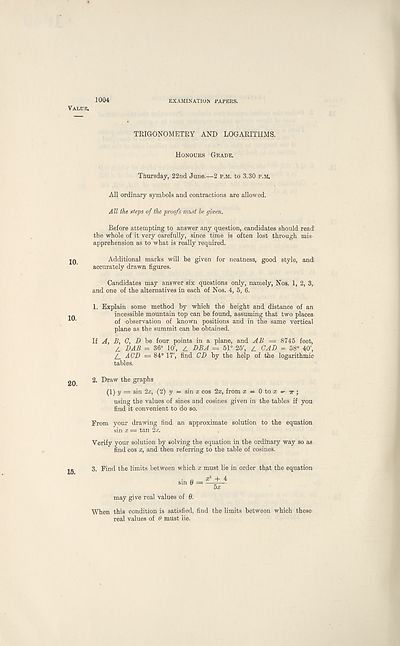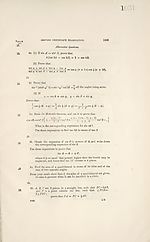Browse and search > 1905 - Leaving Certificate Examination
(54) Trigonometry and Logarithms, Honours Grade
Download files
Complete book:
Individual page:
Thumbnail gallery: Grid view | List view

1004
EXAMINATION EAFERS.
Value.
TRIGONOMETRY AND LOGARITHMS.
Honours Grade.
Thursday, 22nd June.—2 p.m. to 3.30 p.m.
All ordinary symbols and contractions are allowed.
All the steps of the proofs must be given.
Before attempting to answer any question, candidates should read'
the whole of it very carefully, since time is often lost through mis¬
apprehension as to what is really required.
Additional marks will be given for neatness, good style, and
accurately drawn figures.
Candidates may answer six questions only, namely, Nos. 1, 2, 3,.
and one of the alternatives in each of Nos. 4, 5, 6.
1. Explain some method by which the height and distance of an
incessible mountain top can be found, assuming that two places
of observation of known positions and in the same vertical
plane as the summit can be obtained.
If A, B, C, D be four points in a plane, and AB = 8745 feet,
Z. DAB = 36° 10', Z. DBA = 51° 25', z CAD = 58° 40',
Z_ ACD — 84° 17', find CD by the help of the logarithmic
tables.
2. Draw the graphs
(1) y = sin 2x, (2) y = sin a; cos 2a;, from a; = 0 to a; =• tt ;
using the values of sines and cosines given in the tables if you
find it convenient to do so.
From your drawing find an approximate solution to the equation
sin x — tan 2a:.
Verify your solution by solving the equation in the ordinary way so as
find cos x, and then referring to the table of cosines.
3. Find the limits between which x must lie in order that the equation
may give real values of 0.
When this condition is satisfied, find the limits between which these
real values of 6 must lie.
EXAMINATION EAFERS.
Value.
TRIGONOMETRY AND LOGARITHMS.
Honours Grade.
Thursday, 22nd June.—2 p.m. to 3.30 p.m.
All ordinary symbols and contractions are allowed.
All the steps of the proofs must be given.
Before attempting to answer any question, candidates should read'
the whole of it very carefully, since time is often lost through mis¬
apprehension as to what is really required.
Additional marks will be given for neatness, good style, and
accurately drawn figures.
Candidates may answer six questions only, namely, Nos. 1, 2, 3,.
and one of the alternatives in each of Nos. 4, 5, 6.
1. Explain some method by which the height and distance of an
incessible mountain top can be found, assuming that two places
of observation of known positions and in the same vertical
plane as the summit can be obtained.
If A, B, C, D be four points in a plane, and AB = 8745 feet,
Z. DAB = 36° 10', Z. DBA = 51° 25', z CAD = 58° 40',
Z_ ACD — 84° 17', find CD by the help of the logarithmic
tables.
2. Draw the graphs
(1) y = sin 2x, (2) y = sin a; cos 2a;, from a; = 0 to a; =• tt ;
using the values of sines and cosines given in the tables if you
find it convenient to do so.
From your drawing find an approximate solution to the equation
sin x — tan 2a:.
Verify your solution by solving the equation in the ordinary way so as
find cos x, and then referring to the table of cosines.
3. Find the limits between which x must lie in order that the equation
may give real values of 0.
When this condition is satisfied, find the limits between which these
real values of 6 must lie.
Set display mode to:
![]() Universal Viewer |
Universal Viewer | ![]() Mirador |
Large image | Transcription
Mirador |
Large image | Transcription
Images and transcriptions on this page, including medium image downloads, may be used under the Creative Commons Attribution 4.0 International Licence unless otherwise stated. ![]()
| Scottish school exams and circulars > Leaving Certificate Examination > (54) Trigonometry and Logarithms, Honours Grade |
|---|
| Permanent URL | https://digital.nls.uk/144136660 |
|---|---|
| Shelfmark | P.P. 1906 XXX |
|---|---|
| Attribution and copyright: |
|
| Description | Examination papers for the School Leaving Certificate 1888-1961 and the Scottish Certificate of Education 1962-1963. Produced by the Scotch (later 'Scottish') Education Department, these exam papers show how education developed in Scotland over this period, with a growing choice of subjects. Comparing them with current exam papers, there are obvious differences in the content and standards of the questions, and also in the layout and use of language |
|---|---|
| Additional NLS resources: |
|



